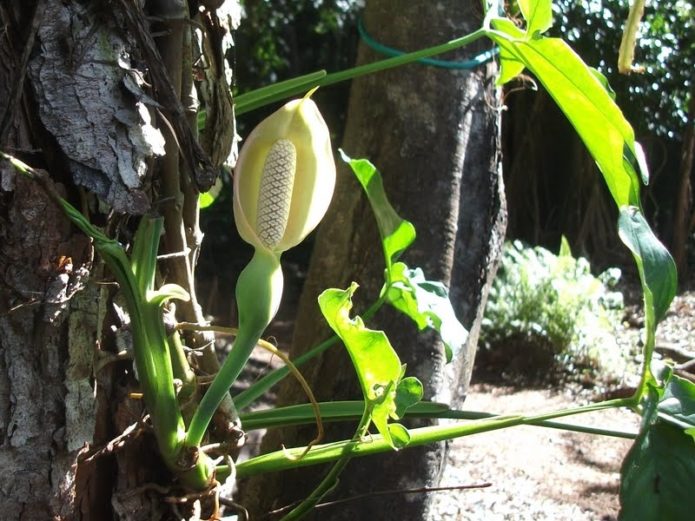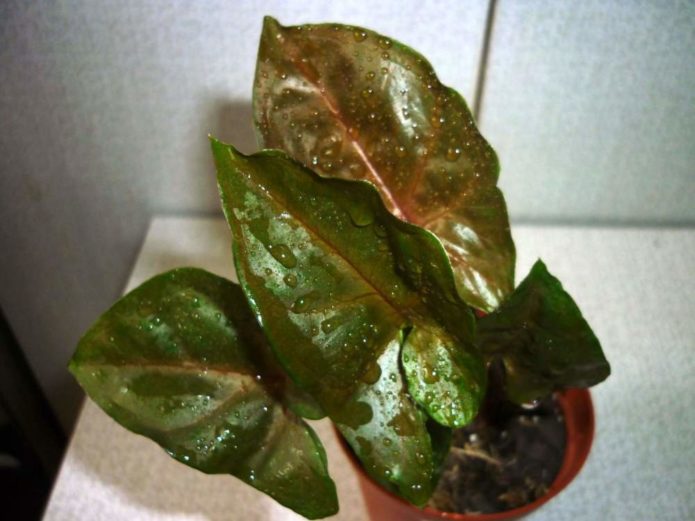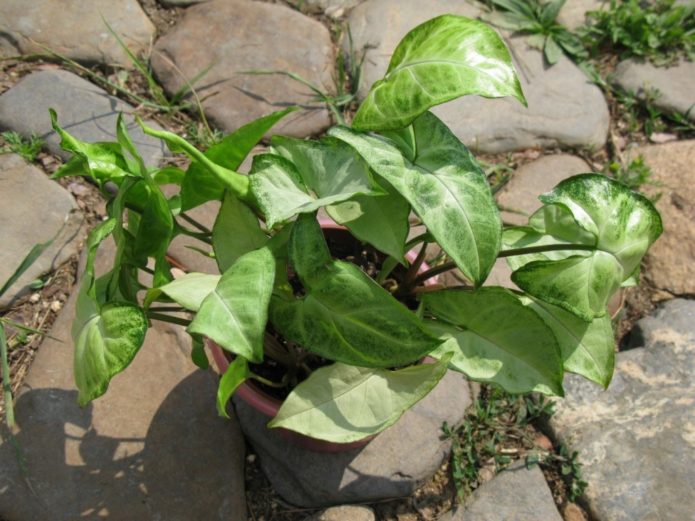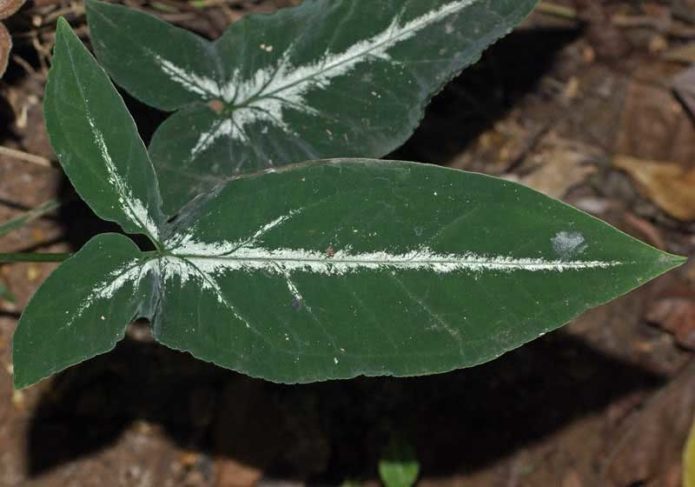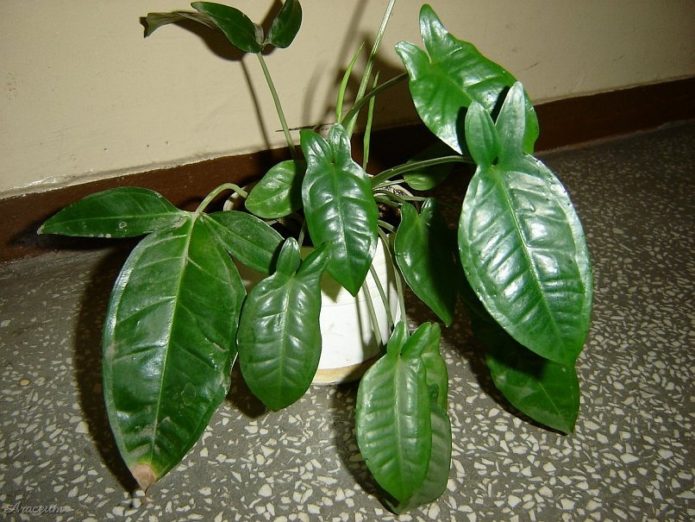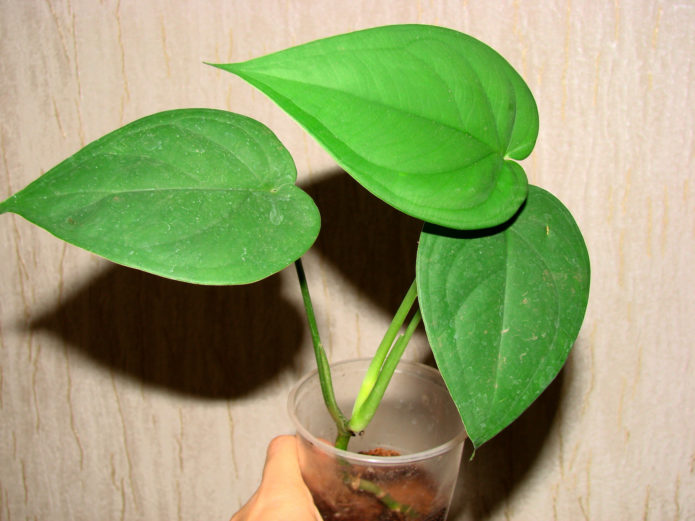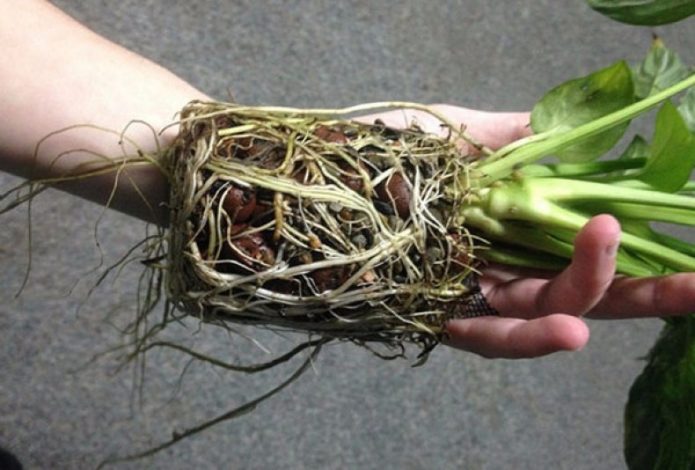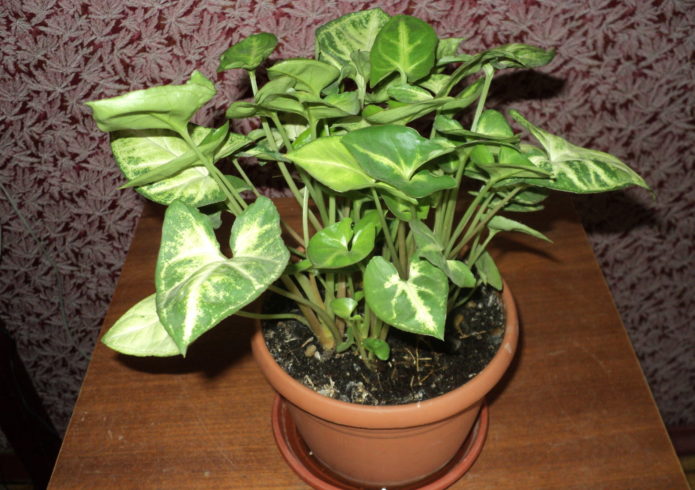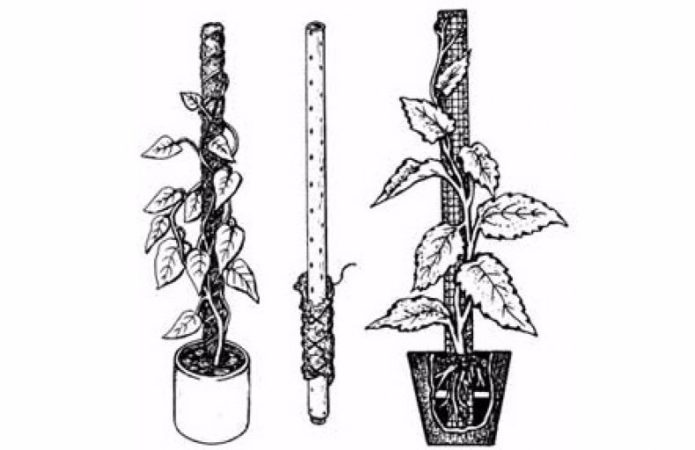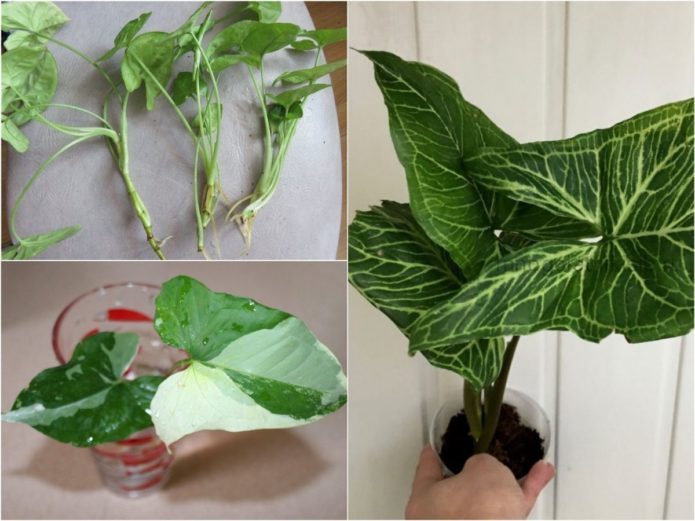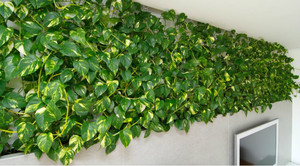Among other indoor plants, syngonium is in great demand. This decorative leafy liana is able to fit into any interior and add home comfort to office premises. A fast-growing and undemanding tropical flower has many positive qualities, and its powerful energy gives the home owners the strength to overcome difficult life situations. No wonder it is shrouded in a mystical tangle of interesting beliefs and legends.
Content
What does a plant look like
Syngonium is an evergreen vine belonging to the Aroid family. A plant native to the rainforests of Central and South America, but despite its exotic roots, it is great for keeping in an apartment.
The non-branching and elastic stems of syngonium in the wild grow up to 20 m in length and 6 cm in diameter, which cannot be achieved with home breeding. In the latter case, the length of the stems does not exceed 2 m, and the thickness is 2 cm. The root system is divided into aerial and feeding roots, which are formed at each stem node.
Different plant varieties have a unique type of leaf plate. The color of the leaves is distinguished by a variety of shades, which can be monochromatic or variegated. In form, they are:
- spear-shaped;
- heart-shaped;
- three-bladed.
The shape and color of the leaf blade often changes depending on the age of the plant or on the lighting. Syngonium blooms only in natural conditions, it is almost impossible to achieve this at home.
Interesting features and signs
There are many superstitions hovering around the syngonium. Like any other vine, it is an energetically strong plant that is often called muzhegon. But for a long time spent next to a person, this omen has not received confirmation. On the contrary, many people notice an improvement in their well-being and emotional state, being in his company.
Due to the frequent change in appearance, the syngonium has become the personification of life changes. People suffering from various diseases quickly recover, and scientists or students observe better assimilation of new material. The plant relieves emotional stress, instills self-confidence, relieves of an inferiority complex and smooths out conflicts.
Despite all the positive properties of syngonium, one should not forget that it is poisonous. Therefore, it must be kept away from children and pets, and transplanted only with gloves.
Main types with photos
There are about 30 species in the genus of syngonium, but only four are suitable for home breeding. Indoor types include:
- Knife-leaved.
- Wendland.
- Eared.
- Large-leaved.
Leafy
This is the most common species, which is also called podophyllum or leg-leaved. It has arrow-shaped leaves and is characterized by rapid growth - up to 60 cm per year.
Wendland
The species is slow growing and has three-lobed leaves. The plant has no varieties, so only its natural form is grown.
Eared
The leaves of this species have a waxy coating, and their shape changes over time - from arrow-shaped to dissected into three or five parts.Stems are strong, prone to woody and fast-growing - up to 90 cm per year.
Large-leaved
Not the most popular type of syngonium, which has large heart-shaped leaves. The length of the leaf plate reaches 20 cm, and in nature up to 30 cm.
Popular varieties with photos
The work of breeders does not stand still, therefore the varietal variety of each species is constantly replenished. The main task is to develop varieties that combine three different shades.
The most interesting varieties:
- Panda.

- Aaron brown.
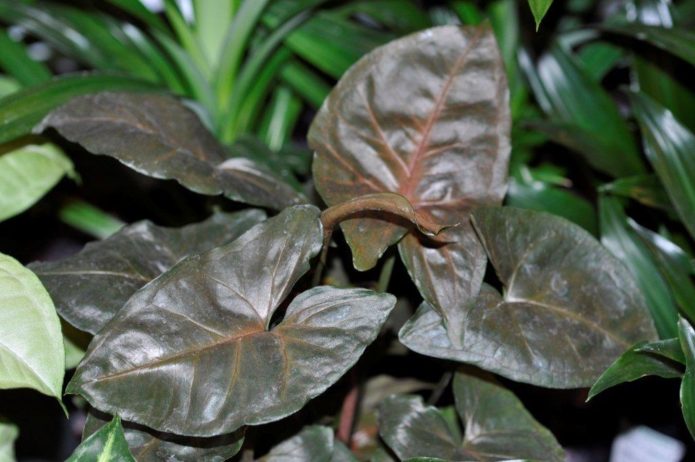
- Three kings.
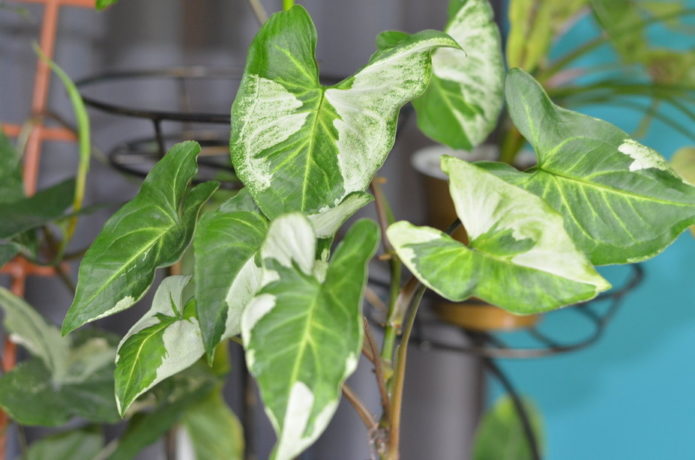
- Pink.
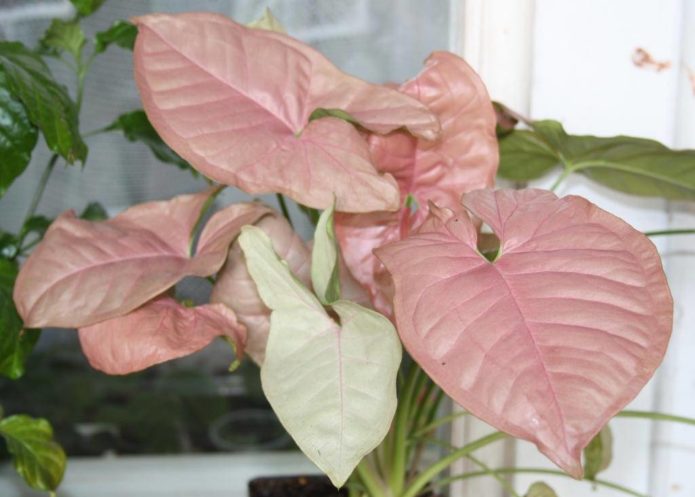
- Regina.
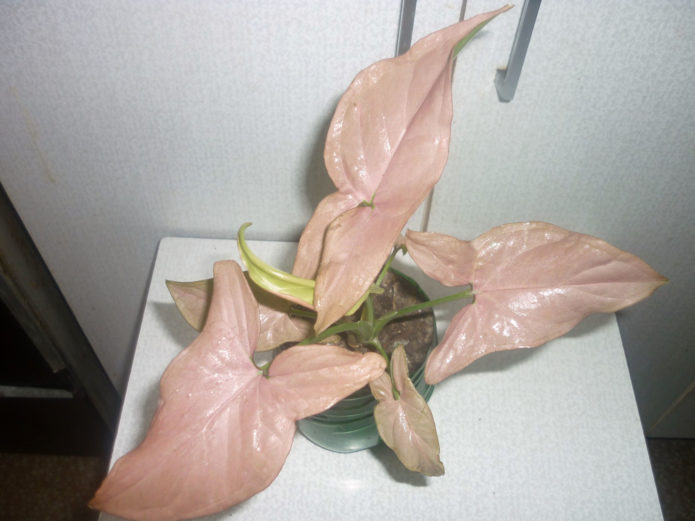
- Tricolor.
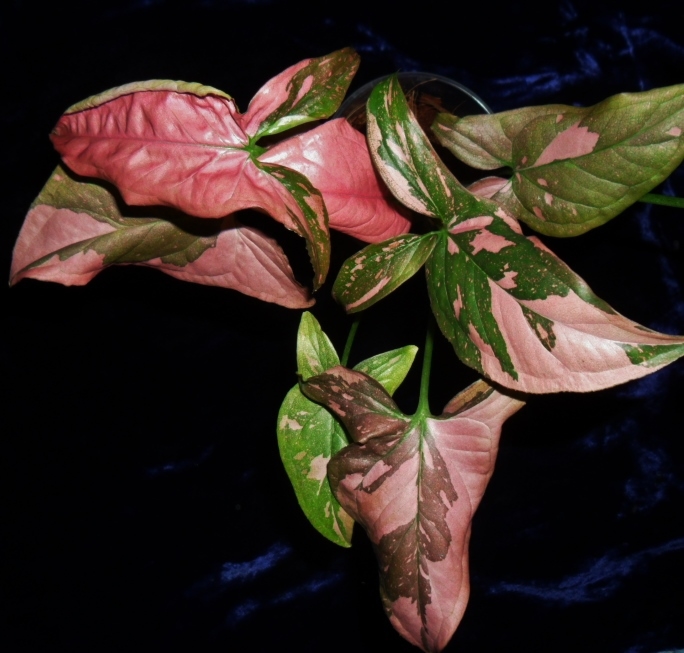
- Green.
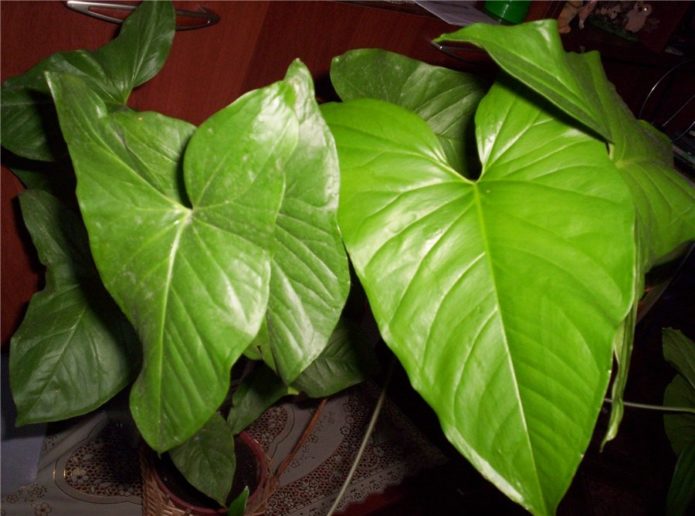
- Freakles.
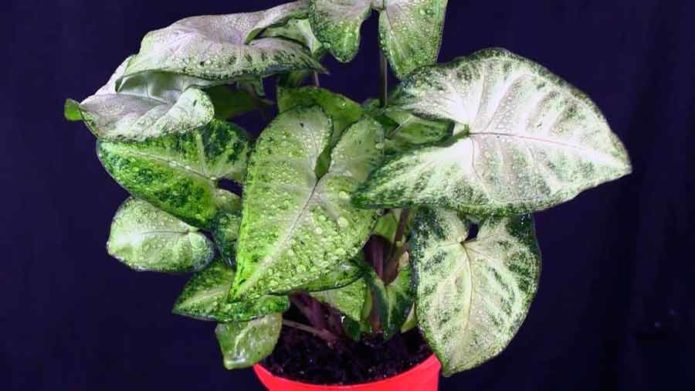
- Jade.
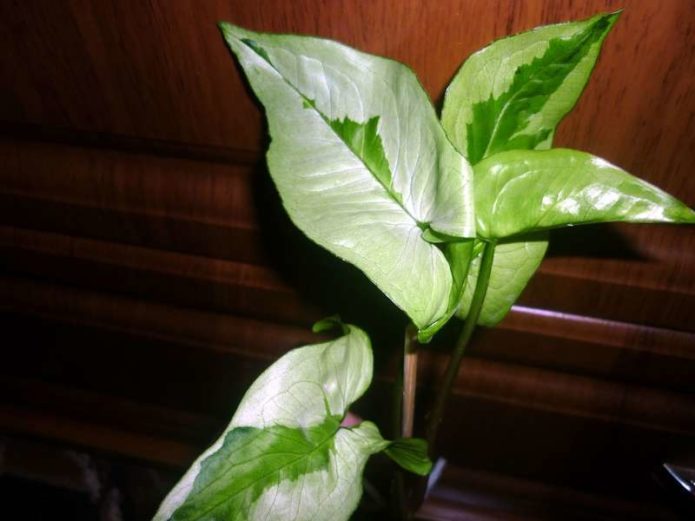
- Silver pearl.
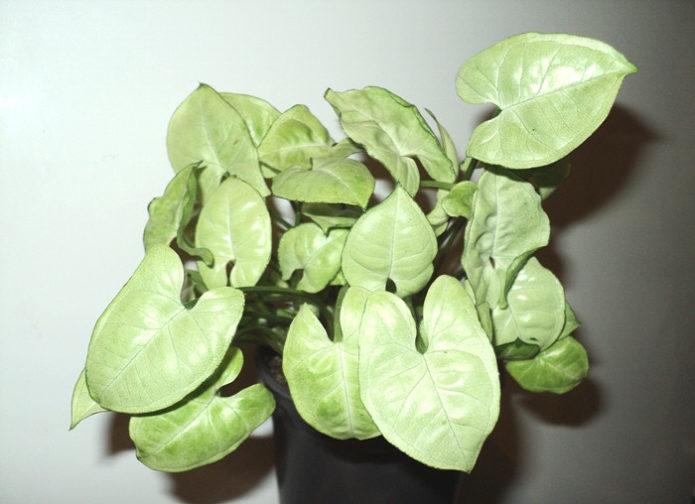
- Pink splash.
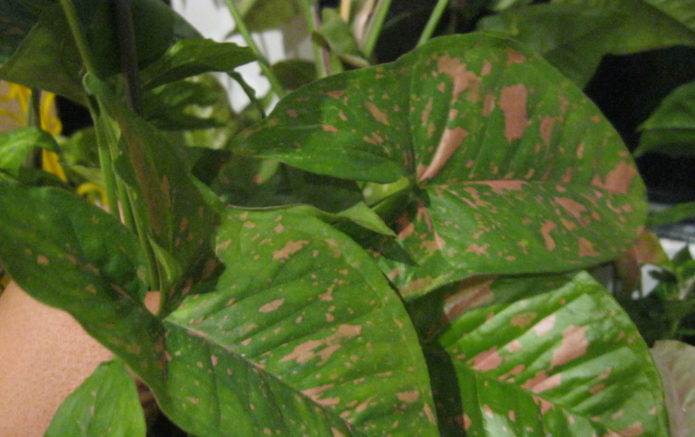
- Mottled.
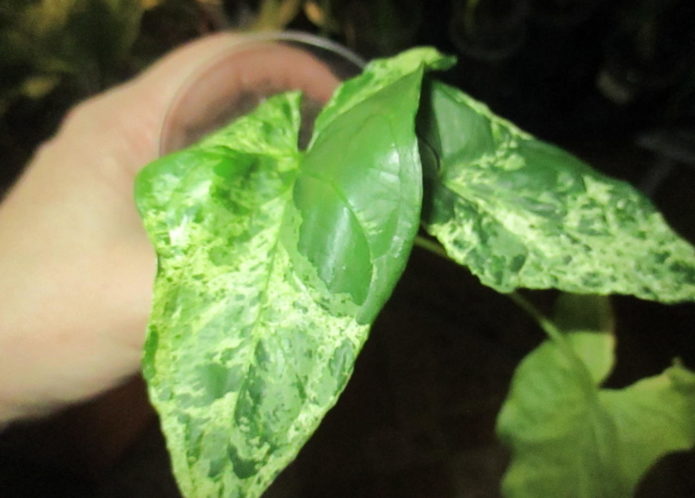
- Tiffany.

- White butterfly.
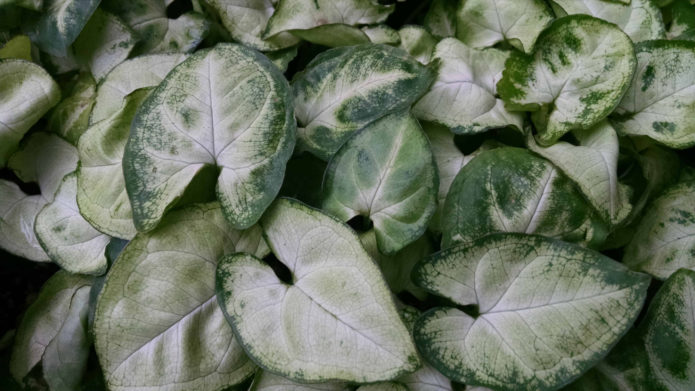
- Christmas.
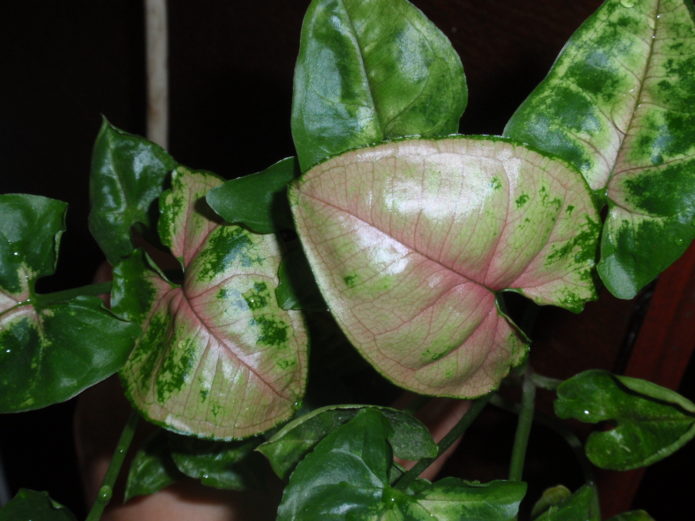
- Confetti.
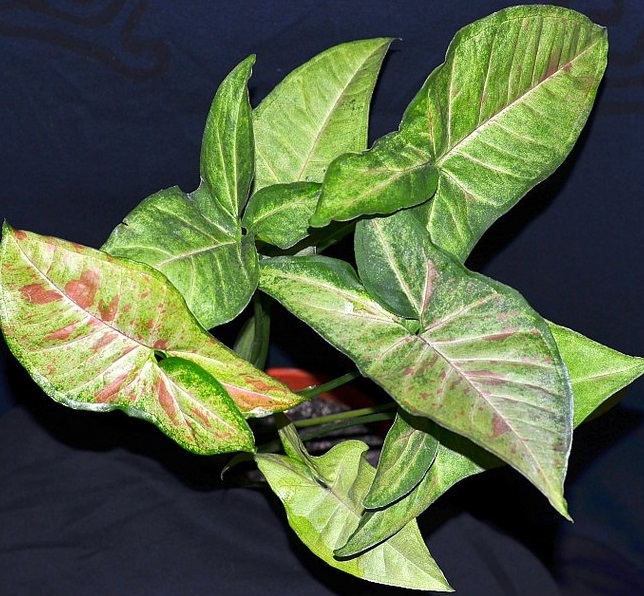
- Red spot.
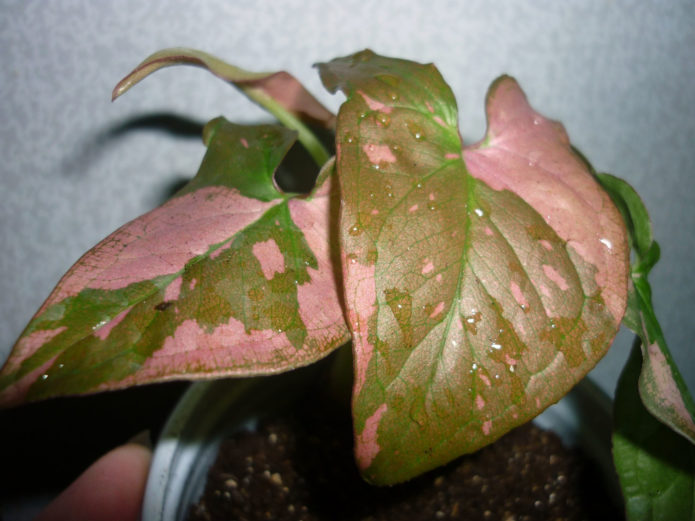
- Neon.
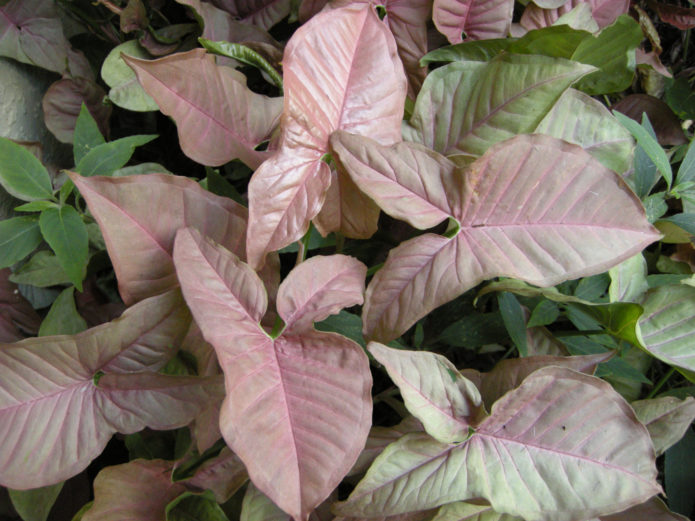
- Pixie.

- Orm nak.
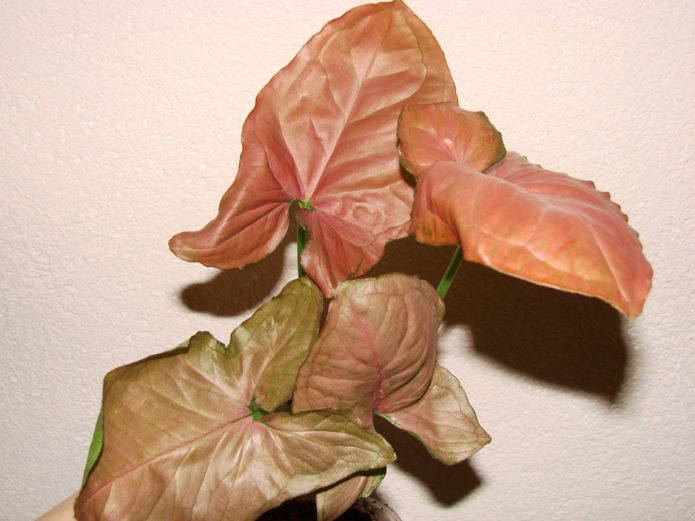
- Arrow.
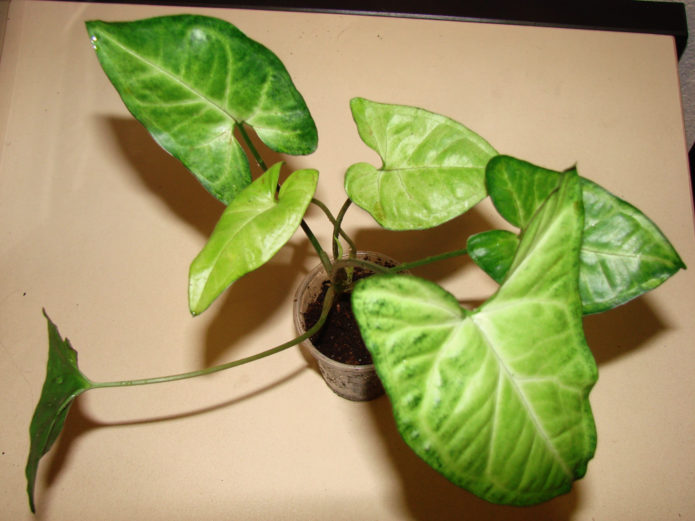
Basic rules of care
Caring for the syngonium at home will not seem difficult even for a newly-made florist. The main criterion for maintaining the appearance and well-being of a plant is its correct location. The flower loves partial shade, and direct sunlight has a detrimental effect on its decorative qualities. The most suitable place for him will be windows facing the west or east side.
Table. Features of care depending on the season
| Criterion | Spring Summer | Autumn winter |
| Temperature |
|
|
| Watering and moisture |
|
|
| Lighting |
|
|
| Fertilizer |
|
|
Syngonium is distinguished by a pronounced dormant period in winter, but at the same time it does not shed excess foliage. At this time, it stops growing and does not need fertilization and abundant watering.
Soil selection and replanting
For better flower development, preference should be given to slightly acidic or neutral soil with an acid-base balance within 6–7 pH. The soil should be loose, nutritious and permeable to moisture and air.
You can buy ready-made earthen mixture in a specialized store or prepare it yourself. This requires:
- sheet land - 1 part;
- turf - 1 part;
- peat - 1 part;
- river sand - 0.5 parts.
The new container for keeping the plant should not be much larger than the old one. It is better if it is made of chamotte clay or ceramics. A prerequisite is the presence of drainage holes to drain excess water.
It is necessary to replant young bushes once a year, and adult plants - once every 2-3 years, provided that the roots appear from the drainage holes. After purchase, the flower is transplanted no earlier than a month later.
Step-by-step instructions for transplanting in the spring:
- A drainage layer of expanded clay, nutshells or broken brick is poured onto the bottom of the pot.
- Establish a solid support.
- The length of the shoots is shortened by half.
- The roots of the plant are carefully untangled.
- Having placed the flower in a new pot, sprinkle the roots with ready-made soil and lightly tamp.
- The soil is moistened with warm water.
- The pot is placed in a warm place with good lighting.
- Fertilize the plant only a month after transplanting.
Bush formation
Due to the good tolerance of pruning, syngonium is very easy to shape. Due to the lack of branching, it is often grown as an ampelous plant, and if you install a solid support, you can form a flower in the form of a tree.
To stimulate the appearance of lateral shoots in young plants, the tip is pinched after the formation of the third leaf, and in adult specimens after the sixth or seventh. To give a more lush shape to the bush, several sprouts are planted in one pot at once.
To maintain an attractive appearance, weak and ugly shoots are removed every spring.
Difficulties in growing and eliminating errors
Despite the unpretentiousness of the flower, improper care negatively affects the condition of the plant. You can return decorative qualities if you take timely measures to solve the problem.
Common problems:
- Pulling out shoots, pallor of color and reduction in leaf size.
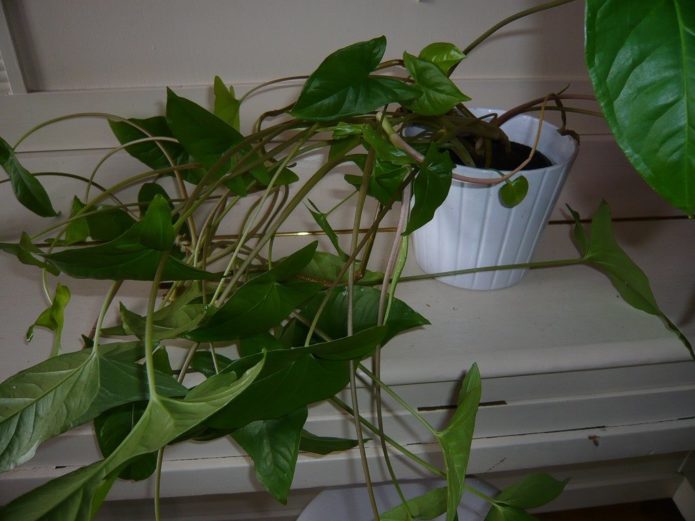 Indicate a lack of sunlight. It is necessary to put the plant closer to the window or supplement it with artificial light.
Indicate a lack of sunlight. It is necessary to put the plant closer to the window or supplement it with artificial light. - Brown spots on the leaves.
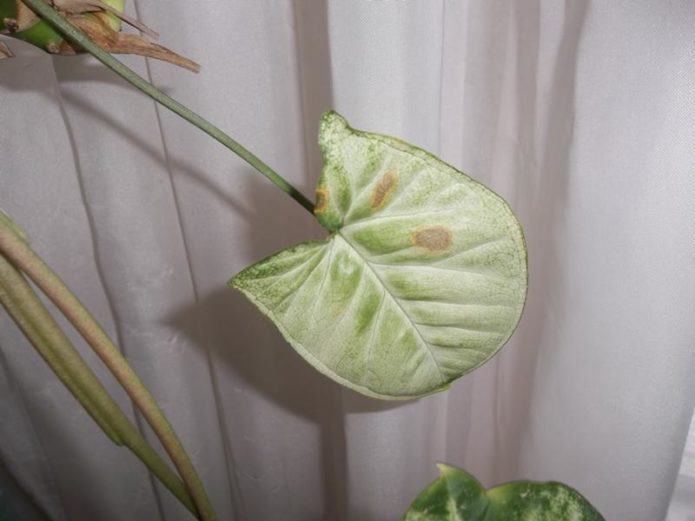 They talk about the formation of sunburn. It is necessary to rearrange the plant in partial shade or shade with a curtain.
They talk about the formation of sunburn. It is necessary to rearrange the plant in partial shade or shade with a curtain. - Sluggish faded leaves.
 Excessive watering or stagnation of moisture in the pan leads to a deterioration. It is worth reducing watering, and if necessary, transplant the plant into a pot with loose soil and a good drainage layer.
Excessive watering or stagnation of moisture in the pan leads to a deterioration. It is worth reducing watering, and if necessary, transplant the plant into a pot with loose soil and a good drainage layer. - Yellowing of the leaves.
 The reason is inadequate intake of nutrients. Do not forget about regular fertilization during the period of active growth.
The reason is inadequate intake of nutrients. Do not forget about regular fertilization during the period of active growth. - Dryness of the edge of the leaf plate with the appearance of brown or yellow spots.
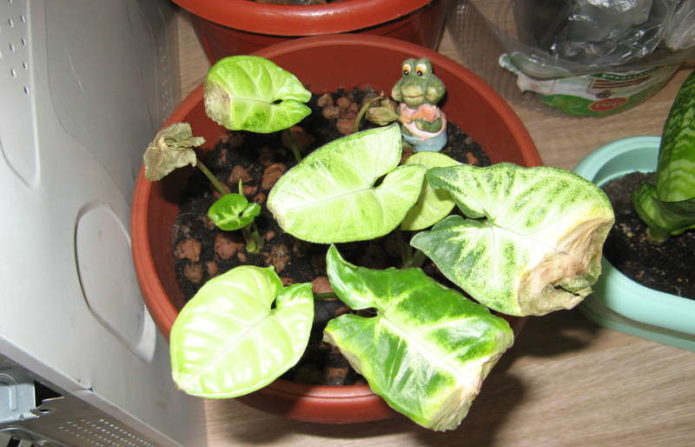 Indicates too dry indoor air, low temperature or waterlogged soil. It is worth revising the rules of care and installing a humidifier.
Indicates too dry indoor air, low temperature or waterlogged soil. It is worth revising the rules of care and installing a humidifier. - The appearance of water droplets on the leaves.
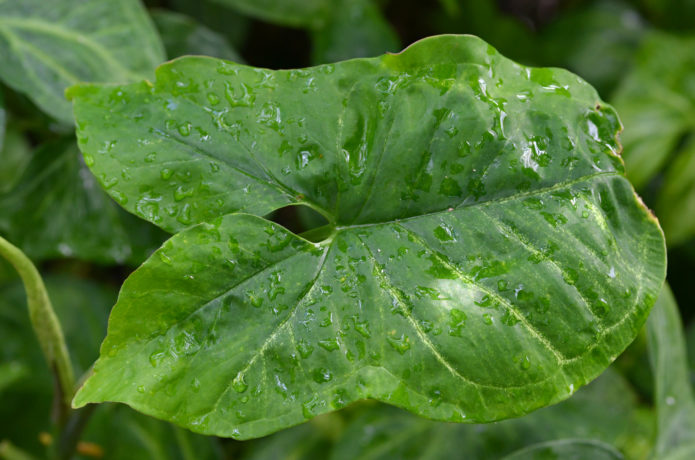 This is a sign of excessive moisture or over-watering. It is necessary to adjust air and soil moisture.
This is a sign of excessive moisture or over-watering. It is necessary to adjust air and soil moisture.
The appearance of vines is often influenced by various insects. You can find them with a careful examination of the plant. Most often, the syngonium is attacked by aphids, scale insects, spider mites and thrips. Many insecticidal preparations are sold in stores, such as Fitoverm, Intavir, Actellik, which quickly get rid of the problem. Additional processing may be required for best results.
Reproduction
The main methods of reproduction of syngonium are cuttings or rooting of a part of the stem, which allow you to quickly and easily grow a new bush. It is almost impossible to get a plant from seeds.
Breeding rules by cuttings:
- Cut off the top of the stem about 15 cm long and 2–3 knots with aerial roots.
- Placed in a glass with warm water and a crushed tablet of activated carbon or directly into the ground.
- Cover with a bag and place in a room with a temperature of 25-27 ° C.
- After rooting, the sprouts are seated in separate containers.
Propagation by part of the stem:
- A drainage layer is poured into a separate pot.
- Prepared soil is poured and placed next to the mother plant.
- A stalk with aerial roots from an adult bush is applied to a new pot, sprinkled with earth and secured with a paper clip.
- It is watered as needed for two weeks.
- After fixing part of the stem in a new pot, it is cut off from the main bush.
Syngonium is an evergreen and unpretentious plant that can fit into any environment.It can be grown both in hanging pots and with the help of a support, while any option will add charm to the interior.
